
|







(alphabetical and illustrated) Introduction | A - 1 | A - 2 | B - 1 | B - 2 | C - 1 | C - 2 | C - 3 | D | E | F G - H | I - J - K | L - M | N - O | P | Q - R | S - 1 | S - 2 | T | U - V - W - X - Y - Z |
|
|
|
|
| the audio portion of a film including dialogue, music, and effects; sound effects refers to all created sounds except dialogue or music | ||
(or stage) |
a large, soundproof area/room in a studio used in film production, where elaborate sets may be constructed, to allow film-makers greater control over climate, lighting, and sound, security, and spectators. |  Example:
The "You Were Meant For Me" scene deliberately shot on an
empty sound stage, in Singin' in Rain (1951). Example:
The "You Were Meant For Me" scene deliberately shot on an
empty sound stage, in Singin' in Rain (1951). |
| technically, this term refers to the audio component of a movie, including the dialogue, musical score, narration, and sound effects, that accompany the visual components. Popularly, it refers to a collection of songs heard during the movie, and often sold as an album. | 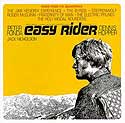 Example:
Soundtrack from Easy Rider (1969) Example:
Soundtrack from Easy Rider (1969) |
|
| a western, low-budget B-movie filmed in Italy (or Spain) during the 60s, usually characterized by low production values, sparse dialogue. |  Examples:
Sergio Leone's westerns, starring Clint Eastwood as an amoral drifter
- the poncho-clad gunslinger Blondie. Examples:
Sergio Leone's westerns, starring Clint Eastwood as an amoral drifter
- the poncho-clad gunslinger Blondie. |
|
| an unsolicited or non-commissioned ("speculative") screenplay sent to a studio by a screenwriter for consideration (hoping that it will possibly be 'optioned' or purchased); aka speculative screenplay | ||
(or F/X, SFX, SPFX, or EFX) |
a broad, wide-ranging term used by the film industry meaning to create fantastic visual and audio illusions that cannot be accomplished by normal means, such as travel into space. Many visual (photographic) or mechanical (physical) filmic techniques or processes are used to produce special illusionary effects, such as optical and digital effects, CGI, in-camera effects, the use of miniatures/models, mattes, rear-camera projections, stop-motion animation, bluescreens, full-scale mockups, pyrotechnics (squibs (miniature explosions, i.e. a gunshot)), stunt men, animatronics (electronic puppets), rain/snow/wind machines, etc.; F/X are coordinated by the visual effects and the special effects supervisors; known negatively as trick photography; see also visual effects - a sub-category of special effects. See this site's Milestones in Special/Visual Effects in Film History. |  King Kong (1933) and the use of models  Hitchcock's The Birds (1963)  The Incredible Shrinking Man (1957) |
| refers to a derivative work (film or TV), either a sequel or a prequel which includes characters from the previous original product; contrast to a prequel, follow-up, serial, series, sequel or remake | Examples: The Scorpion King (2002) was a spin-off of The Mummy Returns (1999) with the character of the Scorpion King (Dwayne Johnson); or Alien vs. Predator (2004) - an obvious spin-off of previous hits; Laverne & Shirley was a spin-off of the TV show Happy Days | |
| an editing technique used to ease the transition from one scene to another, in which the audio starts before (or after) the picture cut; aka L-cut or J-cut | ||
| in the silent era, refers to two different short-subject films (each too brief for a separate screening) that were joined together on one reel for movie-house exhibition | ||
| the combination of two actions filmed separately by copying them onto the same negative and having them appear side-by-side within a single frame (without overlapping); a slight variation on split-screen is termed multiple image (different images are set alongside each other within a single frame); split-screen is usually intended to signify simultaneous action; also see bluescreen and matte shot |   Examples include: phone conversations between Rock Hudson and Doris Day in Pillow Talk (1959) (shown above); Woodstock (1970), The Thomas Crown Affair (1968), Napoleon (1927), and The Grifters (1990) (shown above); also in scenes between an actor and a wild animal on different sides of the frame, used in Bringing Up Baby (1938), Forbidden Planet (1956), and Krull (1983). |
|
| information about the plot or ending of a film that may damage or impair the enjoyment of the film if known ahead of time; usually, critics or reviewers warn readers with a 'spoiler alert', or avoid revealing spoilers altogether. See Greatest Plot Twists and Spoilers |
|
|
| usually a comedic film that pays tribute to an earlier film in a humorous way. |
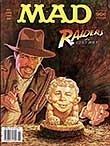 Raiders of the Lost Ark (1981) was spoofed as 'Raiders of a Lost Art' in MAD Magazine (Jan '82) |
|
| a substitute person who is physically similar (in size and appearance) to an actor and who takes the actor's place during often lengthy preparation of a scene (the taking of light meter readings, camera setup, light adjustment, etc.) but not during filming. Not to be confused with a stunt double or a body double. | ||
| the name given to famous, talented, and popular actors or celebrities, often in lead character roles, who can draw an audience to a film with their photogenic appearance, inspirational acting, or some other quality. Historically, a starlet (or ingenue) was an attractive actress promoted by a film studio in a small role as an up-and-coming star during the 40s and the 50s; also used in the term star quality and star system |  Example:
Mel Gibson, director and star of Braveheart (1995) Example:
Mel Gibson, director and star of Braveheart (1995) |
|
| refers to the way in which studios "groomed" stars under contract, and sought star vehicles for them; studios served as protectorates for their stars | ||
| a film expressly made to show off the talents of a performer, with all other aspects almost secondary; compare with tour de force | Examples: Twentieth Century (1934) with John Barrymore; Victor/Victoria (1982) with Julie Andrews (whose husband Blake Edwards wrote and directed) | |
| an unmoving or immobile camera shot that is stationary, due to the use of a tripod | ||
|
|
a hand-held camera technique using a stabilizing Steadicam (introduced in the late 70s), developed by inventor Garrett Brown, with a special, mechanical harness that allows the camera operator to take relatively smooth and steady shots, though hand-held, while moving along with the action; the resulting images are comparable to normal tracking shots on a wheeled dolly |
Examples: earliest use in Bound for Glory (1976), some uses also in Rocky (1976), in the lengthy tracking shots down the corridors of the Overlook Hotel in Kubrick's The Shining (1980), and in Return of the Jedi (1983); also the over 5-minute uncut Steadicam shot along the beach at Dunkirk in Atonement (2007) |
|
(or scene-stealing) |
usually refers to a supporting actor/actress attracting attention from the lead actor or actress to whom the center of interest legitimately belongs; see also 'tour de force' performance | |
|
|
the act of portraying a particular character (or group) with a formulaic, conforming, exaggerated, and oversimplified representation, usually offensive and distorted | Example: in Breakfast at Tiffany's (1961), the portrayal of Audrey Hepburn's upstairs neighbor, Mr. Yunioshi (Mickey Rooney) in an exaggerated way: with buck-teeth, a pronounced accent, and comic ineptness - all conveying a degrading and stereotypical view of Japanese or Asian men; this scene was also replayed in Dragon: The Bruce Lee Story (1992) |
|
|
refers to a single, static image, either (1) a frame still (possibly enlarged) from a finished film, (2) a production still taken from an unfinished film, or (3) a publicity shot (of an actor or scene); aka photogram. |
 Example: a publicity still of the major cast members of The Wizard of Oz (1939) and  a still taken from To Kill a Mockingbird (1962) |
| a surprising, last-minute bit of dialogue (or footage) that appears after the end (or closing) credits |  Example:
title character Ferris (Matthew Broderick) breaks the fourth wall and
tells the audience: "You're
still here? It's over! Go home. Go!" in Ferris Bueller's Day
Off (1986); or the end of The Muppet Movie (1979) when Animal yells
at the audience: "Go home! Go home! Bye-Bye." Example:
title character Ferris (Matthew Broderick) breaks the fourth wall and
tells the audience: "You're
still here? It's over! Go home. Go!" in Ferris Bueller's Day
Off (1986); or the end of The Muppet Movie (1979) when Animal yells
at the audience: "Go home! Go home! Bye-Bye." |
|
|
|
a minor character whose actions are completely predictable, stereotypical, or standard for his/her job or profession; similarly, a stock situation is a basic, recognizable plot situation (e.g., a lover hiding in the closet, twins mistaken for each other, etc.). | Examples: the wily servant, the braggart soldier, the innocent virgin, a drunken husband, etc. |
|
(or stock/library shot) |
refers to previously-shot or recorded footage or film of common elements or scenes, such as canyons or deserts in the American West, or travelogue shots (e.g., skylines, airplane takeoffs/landings, famous places, etc.), or historical events footage, that are kept in a film archive or library and used by editors to fill in portions of a movie in different film productions, thereby saving the time of reshooting similar scenes over and over; a stock shot refers to an unimaginative or commonplace shot that looks like it could be stock footage | Example: The DC-3 flying over the Himalayas when Indy leaves Nepal in Raiders of the Lost Ark (1981) was lifted from Lost Horizon (1973); many films use historical footage of the bombing of Pearl Harbor, street scenes in NYC, or destruction sequences |
|
(animation) |
a special-effects animation technique where objects, such as solid 3-D puppets, figures, or models are shot one frame at a time and moved or repositioned slightly between each frame, giving the illusion of lifelike motion. Stop-motion was one of the earliest special-effects techniques for science-fiction films, now replaced by CGI and animatronics; aka stop-frame motion |  Example:
the stop motion animation in the first great monster movie, King
Kong (1933); also in the landmark films by Ray Harryhausen such as Jason and the Argonauts
(1963); The Adventures of Mark Twain (1985), The Sandman (1991),
Wallace & Gromit: Curse of the Were-Rabbit (2005) and Corpse
Bride (2005) Example:
the stop motion animation in the first great monster movie, King
Kong (1933); also in the landmark films by Ray Harryhausen such as Jason and the Argonauts
(1963); The Adventures of Mark Twain (1985), The Sandman (1991),
Wallace & Gromit: Curse of the Were-Rabbit (2005) and Corpse
Bride (2005) |
|
|
the events
that appear in a film and what we can infer from these events; aka narrative
or plot |
|
|
|
a sequential series of illustrations, stills, rough sketches and/or captions (sometimes resembling a comic or cartoon strip) of events, as seen through the camera lens, that outline the various shots, indicate camera angles, blocking of actors, and the size of the frame; they provide a synopsis for a proposed film story (or for a complex scene) with its action and characters; the storyboards are displayed in sequence for the purpose of visually mapping out and crafting the various shot divisions and indicating camera movements in an animated or live-action film; a blank storyboard is a piece of paper with rectangles drawn on it to represent the camera frame (for each successive shot); a sophisticated type of preview-storyboard (often shot and edited on video, with a soundtrack) is termed an animatic |
|
|
|
an actor/actress who serves as a stooge for a comedian (or funnyman), usually by adopting a serious stance or reaction to the comic partner; the straight man often feeds lines to the other irreverent comedian - who replies with witty comments; aka second banana or foil |  Examples:
Margaret Dumont in numerous Marx Brothers films (pictured here in the opening
scene with Groucho in A Night at the Opera (1935));
also Bud Abbott to Lou Costello. Examples:
Margaret Dumont in numerous Marx Brothers films (pictured here in the opening
scene with Groucho in A Night at the Opera (1935));
also Bud Abbott to Lou Costello. |
|
|
(1) the for-profit companies that specialize in developing, financing and distributing most American commercial films; (2) also refers to the actual site for a film production, with physical sets, stages, offices, backlots (located on the outdoor grounds of a film studio and used for filming exteriors), etc; see also majors and independents, and mogul. |
 Example: An archival view of the front entrance to Paramount
Pictures film studio.
Example: An archival view of the front entrance to Paramount
Pictures film studio. |
|
|
the head or chairperson of a film studio who has the final authority for each film project (gives the green light - or authorization go-ahead), and oversees the many departments (financial, legal, marketing, advertising, distribution, etc.); also called the topper; in Hollywood's Golden Age, the chief was called a mogul |  Example:
studio chief (mogul) Louis B. Mayer of MGM Example:
studio chief (mogul) Louis B. Mayer of MGM |
|
|
refers to the all-powerful control the monopolistic film studios had over all aspects of assembly-line filmmaking and film production from the 1920s until the late 1950s, when chiefs - moguls (Mayer, Selznick and Zukor) ruled; tactics included the ownership of property, control of publicity and marketing, and iron-clad contracts with star-actors, directors, composers, cameramen, costume designers, writers, and producers. | |
|
|
a stunt performer(s) (aka stunts) that take the place of an actor when the scene calls for a dangerous or risky action (car crash, fight, window jump, etc.); doubles usually have the same build or appearance as the star; also called stunt performer, stuntman or stuntwoman; not to be confused with a stand-in or a body double; stunts are supervised, conducted and planned by a stunt coordinator | 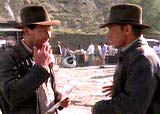 Example:
Harrison Ford with his stunt double Vic Armstrong on the set of Indiana
Jones and the Last Crusade (1989) Example:
Harrison Ford with his stunt double Vic Armstrong on the set of Indiana
Jones and the Last Crusade (1989) |
|
|
a term that refers to the artificial exaggeration or elimination of details in order to deliberately create an effect - in other words, to make (or interpret) a person, a face, a tree, a figure, or something as 'grotesque,' 'disturbing,' or 'overbright' as opposed to realistic or naturalistic. | Examples: James Whale's Bride of Frankenstein (1935), stylized film noir classics T-Men (1947) and He Walked By Night (1948), Joseph Mankiewicz's Guys and Dolls (1955), or Fellini's 8 1/2 (1963) |
|
point-of-view (POV) |
a film in which the narrator has a limited point-of-view regarding the characters, events, action, places, thoughts, conversations, etc.; a subjective camera is a style of filming that allows the viewer to look at events from the POV of either a character or the author, when the camera position is close to the line of sight of the character; contrast to omniscient point-of-view | 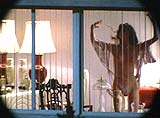 Examples:
Many of Hitchcock's films featured a subjective POV (ie. Scottie Ferguson's
(James Stewart) distorting, swirling POV in Vertigo
(1958) or Rear Window (1954)), or
in Brian DePalma's Body Double (1984) (pictured); the many POV shots
in 2001: A Space Odyssey (1968) (from computer
HAL 9000's POV as well as Dave Bowman's (Keir Dullea)), and John Carpenter's
Halloween (1978)) featured POV shots from
Michael Myers and Laurie Strode (Jamie Lee Curtis) Examples:
Many of Hitchcock's films featured a subjective POV (ie. Scottie Ferguson's
(James Stewart) distorting, swirling POV in Vertigo
(1958) or Rear Window (1954)), or
in Brian DePalma's Body Double (1984) (pictured); the many POV shots
in 2001: A Space Odyssey (1968) (from computer
HAL 9000's POV as well as Dave Bowman's (Keir Dullea)), and John Carpenter's
Halloween (1978)) featured POV shots from
Michael Myers and Laurie Strode (Jamie Lee Curtis) |
|
|
a secondary, subordinate, or auxiliary plotline, often complementary but independent from the main plot (the A story), and often involving supporting characters; not the same as multiple plotlines; aka the B story or C story | Example: one of the film's many plotlines - 'video peeping tom' Ricky Fitts (Wes Bentley), the abused teenaged son of repressed and Nazi-worshipping Col. Fitts (Chris Cooper), the next door neighbor, and how Lester Burnham (Kevin Spacey) was mistaken for being gay in American Beauty (1999) by Col. Fitts. |
|
|
the deeper and usually unexpressed "real" meanings of a character's spoken lines or actions - if the viewer can 'read between the lines'. | |
|
|
refers to the printed line(s) of text superimposed and displayed at the bottom of the screen frame, often used to translate a foreign-language phrase, or to describe a time/place; also the text translating an entire foreign language film (that hasn't been dubbed); often termed caption |
 Example:
Subtitle in Close Encounters of the Third Kind
(1977). Example:
Subtitle in Close Encounters of the Third Kind
(1977). |
|
|
short for the influential Sundance Film Festival, known for the exhibition and screening of the best of independent films each year in Utah; also see (film) festival | |
|
(or superimposition) |
an optical printing process that places or 'exposes' one image on top of another on the same piece of filmstock, such as inserted credits and titles at the beginning of a film; sometimes composed as a double exposure |
 Example:
in Hitchcock's Vertigo (1958) during
Scottie's nightmare sequence, his face is superimposed over a drawing, Example:
in Hitchcock's Vertigo (1958) during
Scottie's nightmare sequence, his face is superimposed over a drawing,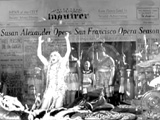 or
in Citizen Kane (1941) the
superimposition and exposure of two images: reviews in the SF Newspaper
and Susan Alexander's performance. or
in Citizen Kane (1941) the
superimposition and exposure of two images: reviews in the SF Newspaper
and Susan Alexander's performance. |
|
(or players, characters) |
characters seen less frequently than the lead role characters, but still in important, secondary roles; often termed a featured player or feature player; well-known guest stars often play brief supporting roles in a film; character actors are usually in supporting roles | |
|
|
a term applied to a film, signifying a distorted or fantastic dream state, a nightmarish or hallucinogenic world, or a subconscious thought or death experience; often expressed by a random, non-sequential juxtaposition of images that go beyond realism | 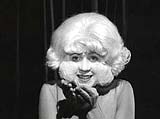 Examples:
the eerie Salvador Dali dream sequence in Hitchcock's Spellbound (1945),
and David Lynch's Eraserhead (1977) (pictured). Examples:
the eerie Salvador Dali dream sequence in Hitchcock's Spellbound (1945),
and David Lynch's Eraserhead (1977) (pictured). |
|
|
another term for a suspense/thriller film | Examples: Most of Alfred Hitchcock's films |
|
|
usually refers to adventure films with an heroic, athletic, sword-wielding character | Example: Errol Flynn's swashbucklers, such as Captain Blood (1935). |
| a term for a movie, usually a Roman or Biblical epic, characterized by the weapons (swords) and footwear (sandals) of the period |  Examples:
the many Victor Mature films, such as Samson and Delilah (1948), The
Robe (1953), and Demetrius and the Gladiators (1954). Examples:
the many Victor Mature films, such as Samson and Delilah (1948), The
Robe (1953), and Demetrius and the Gladiators (1954). |
|
| a term for the class of fantasy movies characterized by the presence of wizards and warriors, magic and sword fighting |  Example: Conan
the Barbarian (1982). Example: Conan
the Barbarian (1982). |
|
| an object in a film that stands for an idea, or that has a second level of meaning to it, e.g., a window or train=freedom, a rose=beauty, a cross-roads=a decision point, etc.; the more a symbol is repeated, the greater its significance | Example: in M. Night Shyamalan's The Sixth Sense (1999) - the visual clue or symbol of cold air indicating the presence of ghost spirits | |
| within a film when two or more distinct plotlines 'mirror' each other or develop variations on the film's theme or plot; aka mirroring | Examples: David Lynch's Lost Highway (1997), and Woody Allen's Crimes and Misdemeanors (1989) | |
| refers to sound whose source can be seen in the image's frame, or whose source can be understood from the context of the image | ||